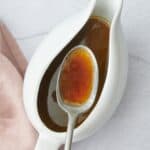How to Make Au Jus
Learn how to make a savory au jus by simmering beef drippings, broth, and seasonings. Ideal for enhancing the taste of your roast beef or prime rib!
Servings: 2 cups
Ingredients
- ¼ cup to ½ cup drippings from Boneless Prime Rib Roast
- 1 onion roughly chopped
- 3 cups beef stock
- 3 sprigs fresh thyme
- salt to taste
- black pepper to taste
Instructions
- If you used a stove-top safe roasting pan, add onion to the drippings and shallots remaining in the pan and cook over medium heat for 3 to 4 minutes, or until the onions start to take on some color.
- Add beef stock and thyme and bring to a boil. Reduce heat to a simmer and cook until the liquid is reduced by two-thirds, about 20 to 25 minutes.
- Taste the drippings and see if additional salt and pepper is needed. Strain through a fine mesh strainer and transfer to a gravy boat or serving vessel.
Notes
The nutrition label reflects 1 cup of broth with the recipe making about 2 cups.
Storage: Store au jus in an airtight container like a mason jar in the refrigerator. To reheat, transfer it to a small saucepan and warm on stovetop over medium heat, stirring occasionally, until heated through.
To freeze: Transfer au jus sauce to a wide-mouth mason jar, leaving at least an inch of headspace to allow for expansion. Freeze for up to 3 months. Thaw overnight in the fridge and reheat per instructions.
Notes:
Deglaze the pan. After roasting prime rib, deglaze the pan with a little bit of stock after removing the meat. Scrape up the flavorful bits from the bottom of the pan and add this liquid to your au jus for an extra boost of flavor.
Use low and slow simmering. Simmer the au jus over low heat for a longer period of time to allow the flavors to meld and intensify. This slow cooking process also helps to reduce the stock to a more a rich and concentrated sauce.
Adjust seasonings as needed. The amount of salt needed will depend on how salty your drippings and the beef stock are. Start low and adjust salt and pepper as needed. Don't over-season because the reduction will intensify the flavors.
Skim the fat after straining. This is optional but helps to maintain balanced flavor and prevents the sauce from becoming too greasy. The best way to skim off excess fat from the au jus is to let is sit for a few minutes and allow the fat to naturally rise to the surface. Then, use a large spoon to scoop out as much as desired.
Nutrition
Calories: 78kcal | Carbohydrates: 11g | Protein: 9g | Fat: 0.5g | Saturated Fat: 0.2g | Polyunsaturated Fat: 0.04g | Monounsaturated Fat: 0.2g | Sodium: 834mg | Potassium: 866mg | Fiber: 1g | Sugar: 5g | Vitamin A: 72IU | Vitamin C: 6mg | Calcium: 52mg | Iron: 2mg
QR code
Scan code to view the full recipe on your phone.
